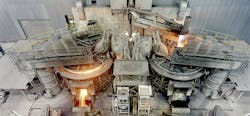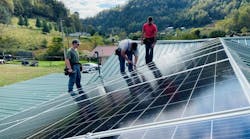The future has arrived, and it’s most certainly electric – as seen in the ongoing renewables boom, rapid acceleration of sustainable transport and continual digitalization.
In this vein, industrial and commercial businesses of all guises, must take progressive action in their own decarbonization journey – through a holistic, integrated approach which takes full stock of new electric technologies and the vast carbon reduction possibilities.
As the electric economy continues to emerge, Calogero Saeli, a Global Product Group Manager within Electrification Distribution Solutions at ABB, advises on the key considerations and solutions for those seeking to ramp up their electrification goals.
-- -- -- -- --
As we enter 2022, it’s astounding to think that there are just eight years left to meet the United Nations’ (UN) target of reducing emissions by 45 percent in order to limit global warming to 1.5°C above pre-industrial levels.1
This is an immense challenge which will require the world to come together to radically change the way it produces and uses energy - and quickly.
This was the rationale behind the recent COP26. Arguably the most important international summit of our lifetime, it saw representatives from 194 countries and 120 world leaders come together in a unity of purpose on the issue of climate change.2
Although many of the key negotiations are yet to be formalized, critically the event marked the first UN climate deal to explicitly mention the need to phase out coal power and subsidies for fossil fuels. It also saw world leaders commit to revisiting and strengthening their nationally determined emissions contributions by the end of this year.2
Underscoring this will be the transition to a modernized economy powered by electricity sourced from renewable, zero-carbon emission sources, coupled with energy-efficient buildings, wider sustainable transport, and a smart infrastructure.
For industry this means redoubling efforts to eliminate energy waste and embrace electrification in order to play its role in changing the trajectory of CO2 levels in the atmosphere.
With so many climate-relevant solutions now on the market, where to begin?
Beneficial Electrification
In line with the wider market, businesses who aren’t already doing so should evolve towards ‘beneficial electrification.’ This is the process of replacing traditional fossil fuel powered solutions, such as furnaces, boilers and water heaters, with efficient electric technologies.
For best results, these electric alternatives can be paired with renewable energy sources by installing on-site renewable systems like rooftop solar panels or wind turbines. Inherently, most industrial and commercial premises typically house enormous vacant, functionless, roof-spaces that are perfect for generating solar energy, while others may have additional unused space suitable for wind farms.
Together, the benefits of this approach are vast. As well as helping to lower energy bills through emissions reductions and increase profitability, it can help businesses reduce, if not negate, their dependence on fossil fuels and natural gas at a time of continued price hikes and market volatility. Importantly too, it can drastically improve brand image as consumers and stakeholders alike continue to gravitate to more sustainable businesses.
There is also the energy storage opportunity, whereby operators can be much more tactical about the way they use the renewable energy they generate in order to reduce cost further.
Battery energy storage solutions, for example, can enable a greater feed-in of renewables into the grid by storing excess generation to enable peak shaving, load shifting and maximization of self-consumption.
Furthermore, in the case that a business has recently extended its electrical infrastructure, battery storage can be used to offset the additional cost brought on by the corresponding large peak loads.
Another big benefit is that these systems can increase grid resiliency and provide critical backup power, preventing revenue losses due to production outages – with power outages in the U.S. alone costing the economy $150 billion annually.3
Powering Sustainable Transport
The sustainable transport transition will form an integral role in achieving carbon neutrality.
This is seen as the UK recently announced a £400 million fund for EV chargers, Italy introduced a comprehensive EV incentives program, and Germany updated its 2030 Climate Plan to continue current incentives well into 2025, with many other countries on the same pathway.4
The result is that EVs, while once a distant reality, are coming to the fore and they’re here to stay.
While this might not seem a natural concern for the industrial or commercial operator, the reality is that it offers another environmental and, in turn, financial opportunity.
It could be, for example, that the remit is to invest in an onsite charging facility for employees as part of a wider incentivization scheme designed to promote EV adoption. Or, that it is to be offered to customers to add value and foster loyalty.
Either way, introducing EV charging as part of the wider sustainability goal can bring a multitude of benefits. On the one hand, it can allow businesses to gain country or continent-specific environmental accreditation and boost brand reputation. More so, as more people come to own EVs, it will ensure they remain one step ahead as both employees and customers come to expect EV charging facilities as the norm.
Importantly too, EV charging points can be a source of extra revenue, whereby businesses can choose to sell electricity to EV owners within the wider public. To put it into context, here at ABB we estimate that the global sustainable transport electrification opportunity for EV passenger car charging solutions alone was worth $3 billion in 2021 – a figure which is only set to grow.5
Power Play
But there’s more. To unlock the full benefits afforded by today’s renewables and electric technologies, it is imperative for operators to obtain a full understanding of their energy usage. They also need to regularly assess their impact and, in doing so, observe any additional savings achieved which can be used to pay for further investment.
In this vein, another eco-opportunity lies in the next generation of smart solutions, such as automation packages, which can provide the insight needed to power all types of large-scale buildings more effectively.
Alongside this too though, it is important not to overlook the importance of ensuring an efficient and reliable electrical supply to power these critical innovations.
By going beyond standard specification habits and making the most of the latest generation of electrical distribution devices, operators can help ensure a consistent electrical supply and, in turn, negate the risk of overloads, short circuits, ground, arc faults and other deviances.
This is imperative on two counts. Of course, amid an increased reliance on more electrical products than ever before, it helps protect businesses from the huge financial and reputational consequences of even just a few moments of downtime. It too, enables a more holistic approach to monitoring in line with establishing a new era of electrical optimization.
Mission Possible
The task of achieving electrification may appear daunting, if not near impossible – especially for highly complex industrial and commercial operators. But it can be done.
This is shown as leading businesses around the world set out on their ambitious roadmaps to achieve carbon neutrality ahead of time – with tactics that include 100 percent renewable energy, zero-to-landfill, closed-loop manufacturing, the deployment of micro-grids and more.6
There is no doubt about it - the movement towards electrification is gaining speed and quickly. And with benefits that include emissions reductions, energy cost savings, additional profit opportunities, futureproofing and an improved brand image, it’s hard to see why any largescale business wouldn’t choose to make the inevitable electric transition sooner rather than later. Surely then it’s time to join the electric revolution?





